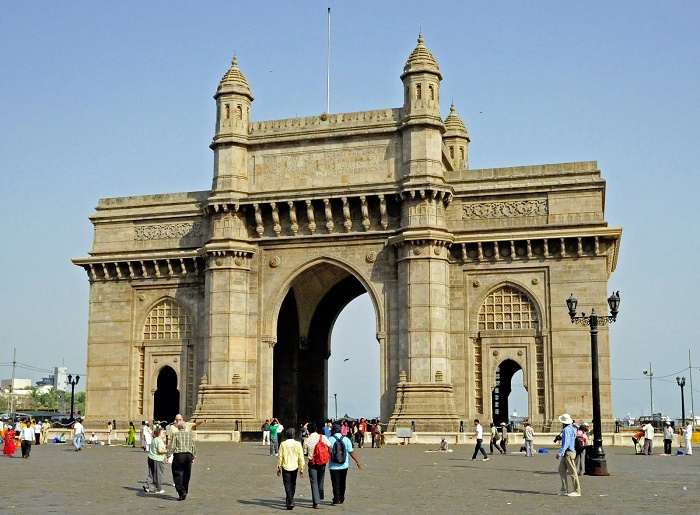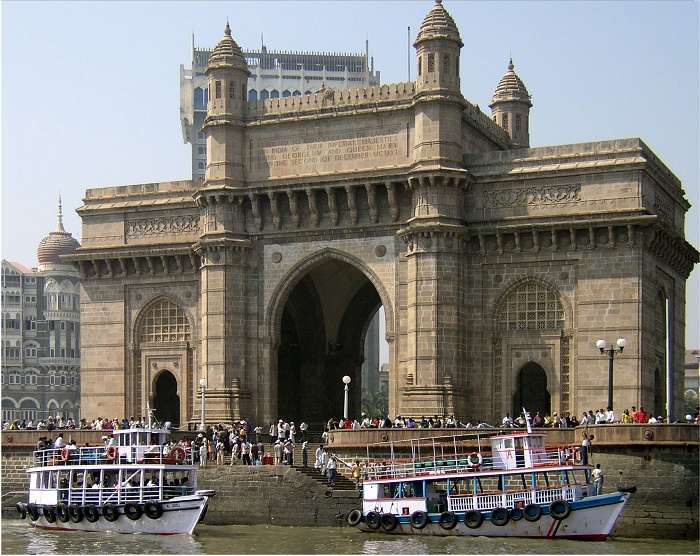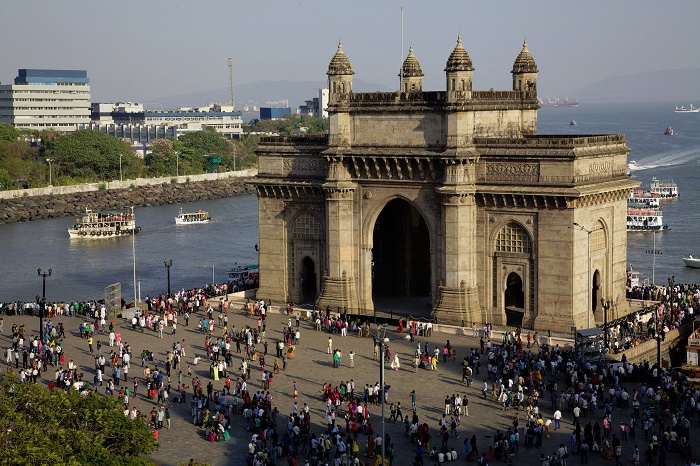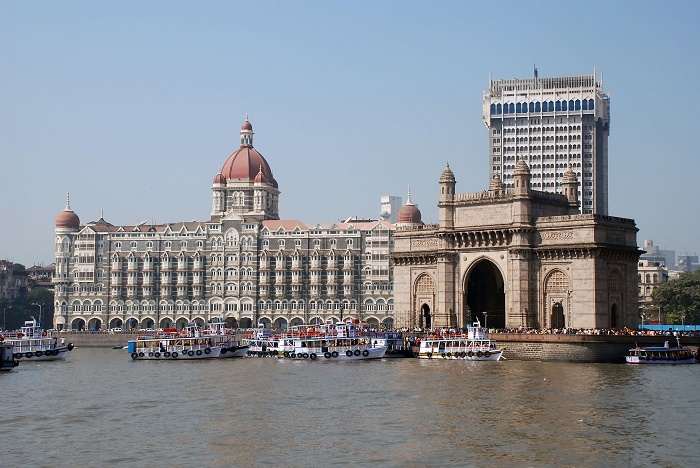Construction Started : 31 March, 1913
Construction Completed : 1924
Inaugurated : 4 December, 1924
Cost of Construction : 2.1 million Rupees in 1913
Maintained By : Archeological Survey of India
Where is it Located : Mumbai, Maharashtra, India
Why was it Built : To commemorate the 1911 royal visit of King George Vand Queen Mary to Mumbai (erstwhile Bombay)
Dimensions : The central dome is 48 feet in diameter and 83 feet in height
Materials Used : Yellow Kharodi basalt and reinforced concrete
Architectural Style : Indo-Saracenic with Muslim influences
Architect : George Wittet
Visit Timing : Open to public 24 hours a day, all days of the week
Entry Fee : No entry fee
How to Reach: Nearest railway station is Churchgate. From there either a shared or individual city taxi can be availed. BEST buses can also be availed from every part of the city to reach Gateway of India.

The Gateway of India, with its regal arches, stands guard facing the Arabian Sea at Apollo Bunder in bustling Colaba area of Mumbai. The most popular tourist attraction, it is the unofficial icon of the city of Mumbai and is a reminder of its rich colonial history as Bombay. The first structure to welcome visitors entering the city by sea, it is popularly called ‘Taj Mahal of Mumbai’. It stands at the end of Chhatrapati Shivaji Marg at the water’s edge. Visited by tourists and locals alike, the gateway and its promenade affords a great view of the boat-studded sea and is the connecting point for boat rides to and from the famous Elephanta Caves. The ‘Elephanta Festival of music and dance’ which was earlier held at the Elephanta caves, is now held in front of the Gateway in March every year. It is often confused with the India Gate in Delhi built in the memory of the 82,000 soldiers of the undivided Indian Army who died in the period 1914–21 in the First World War.

Image Credit: indian-gk.in/wp-content/uploads/2015/06/Gateway_of_India.jpg
History
The Gateway of India was built to celebrate and honor the visit of King George V and Queen Mary to India for their formal proclamation as Emperor and Empress of India at the Delhi Durbar in December 1911. The foundation stone for the monument was laid by Sir George Sydenham Clarke, the Governor of Bombay on March 31, 1911 at what was a crude jetty used by the fishing community. A cardboard model of the proposed structure was presented to the Royal visitors and the final design of Scottish architect, George Wittet was sanctioned on March 31, 1914. Initial work to reclaim land for building the Gateway and a new sea wall at the Apollo Bunder (English: port) was started in 1915. Following completion of land reclamation in 1919, actual construction started and was completed in 1924. The formal inauguration of the Gateway of India was done by the Viceroy of India, Rufus Isaacs, Earl of Reading, on December 4, 1924. The approach road to the Gateway was never built due to lack of funds.
The Taj Mahal Palace hotel located right next to the Gateway of India was built by Jamshedji Tata and catered to a clientele of British elites, European and Indian Maharajas.

Design, Architecture & Structure
The Gateway of India was designed by Scottish architect, George Wittet and the construction work was carried out by Gammon India Limited, the only construction company in India boasting an ISO 9001: 1994 accredited certification in all fields of civil engineering at that time. The structure was built with yellow basalt stones enmeshed with reinforced concrete at the foundations. The stone was sourced locally. The perforated screens were brought from Gwalior. The structure cuts an angle to the road leading to it and stands facing out to the Mumbai Harbor from the tip of Apollo Bunder.
The structure is basically a Triumphal Arch, built predominantly in an Indo-Saracenic architectural style with some Muslim elements incorporated. This style of architecture was introduced by the British during their rule in India and it combines diverse elements of the Hindu and Muslim architecture with Gothic cusped arches, domes, spires, tracery, minarets and stained glass, in a uniquely playful style.
The rectangular structure consists of three sections. The central arches of the structure are 85 feet high. The central block houses a dome which is 48 feet in diameter and 83 feet in height. On each side of the arch, there are large halls with arches that are covered with intricately carved stone screens and can hold 600 people each. The central dome is joined by 4 turrets and is decorated with intricate latticework, the most prominent features of the entire structure of the Gateway of India. Steps from behind the arch of the Gateway lead directly into the Arabian Sea. The arch frames an impressive view of an expanse of Arabian Sea dotted with fishing boats as well as luxury yachts. The structure is illuminated after nightfall presenting a breathtaking view in combination with the adjacent Taj Mahal Palace hotel and tower.
A statue of Chhatrapati Shivaji was inaugurated on 26 January 1961, opposite the gateway as a symbol of Maratha pride and glory. Another statue of Swami Vivekananda is also present in the vicinity to celebrate his journey from Mumbai to Chicago for the Parliament of World Religions.

Significance
The Gateway of India, although built to commemorate the coronation celebration of King George V, became the entry point of British viceroys and governors. Ironically, it is also the site of the symbolic exit of the British from India, signaled by the passing of the first Battalion of the Somerset Light Infantry on 28 February 1948.
A favored tourist spot, the Gateway of India was the target of twin bombing along with the crowded Zaveri Bazar on 25 August, 2003. The incident killed 54 and injured 244 people.
The Gateway was also associated with the 26 November, 2008 terrorist attacks organized by 10 members of Lashkar-e-Taiba, an Islamic militant organization based in Pakistan. The militants disembarked from boats in two groups at the Gateway of India and proceeded to carry out 12 coordinated shooting and bombing attacks in and around south Mumbai, killing more than 150 Indian and foreign nationals.



